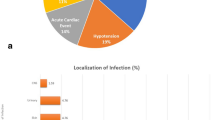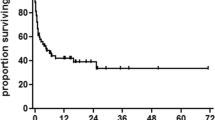Abstract
Purpose
To compare evolution in organ dysfunction (OD) between hematologic malignancy patients with and without bacterial infection (BI) precipitating intensive care unit (ICU) admission, and to assess its impact on mortality.
Methods
Retrospective analysis of prospectively collected data was performed. Sequential Organ Failure Assessment (SOFA) scores from day 1 to 5 were calculated in all consecutive hematologic malignancy patients admitted to the ICU (2000–2006). Patients were categorized according to the presence or absence, the diagnostic certainty, and the site of BI.
Results
Of the 344 patients admitted, 258 were still in the ICU at day 3 and 164 at day 5. Patients admitted because of BI had more severe OD on day 1 (SOFA 9.7 ± 4.0 vs. 8.4 ± 4.0, p = 0.008) but a more rapidly reversible OD within the first 3 days (ΔSOFA −1.12 ± 3.10 vs. 0.03 ± 3.40, p = 0.013) and a lower in-hospital (43.2% vs. 62.9%, p < 0.001) and 6-month mortality (52.1% vs. 71.7%, p < 0.001) than patients with other complications. In a multivariate analysis, BI remained associated with a lower risk of death (OR 0.20, 95% CI 0.1–0.4, p < 0.001) even after adjustment for the SOFA on day 1 (OR 1.36, 95% CI 1.22–1.52, p < 0.001) and the ΔSOFA (OR 1.48, 95% CI 1.29–1.68, p < 0.001). These findings remained significant regardless of the site and the diagnostic certainty of BI.
Conclusion
BI is associated with a more severe initial but a more rapidly reversible OD and a subsequent lower mortality compared to other complications in ICU patients with hematologic malignancies. These findings further support the recommendation that these patients should certainly benefit from advanced life support, and in the case of an uncertain long-term prognosis due to the underlying malignancy, at least from a 3-day ICU trial.

Similar content being viewed by others
References
Azoulay E, Afessa B (2006) The intensive care support of patients with malignancy: do everything that can be done. Intensive Care Med 32:3–5
Groeger JS, Bach PB (2003) Consider saying yes. Crit Care Med 31:320–321
Lamia B, Hellot MF, Girault C, Tamion F, Dachraoui F, Lenain P, Bonmarchand G (2006) Changes in severity and organ failure scores as prognostic factors in onco-hematological malignancy patients admitted to the ICU. Intensive Care Med 32:1560–1568
Benoit DD, Vandewoude KH, Decruyenaere JM, Hoste EA, Colardyn FA (2003) Outcome and early prognostic indicators in patients with a hematologic malignancy admitted to the intensive care unit for a life-threatening complication. Crit Care Med 31:104–112
Larché J, Azoulay E, Fieux F, Mesnard L, Moreau D, Thiery G, Darmon M, Le Gall JR, Schlemmer B (2003) Improved survival of critically ill cancer patients with septic shock. Intensive Care Med 29:1688–1695
Benoit DD, Hoste EA, Depuydt PO, Offner FC, Lameire NH, Vandewoude KH, Dhondt AW, Noens LA, Decruyenaere JM (2005) Outcome in critically ill medical patients treated with renal replacement therapy for acute renal failure: comparison between patients with and those without haematological malignancies. Nephrol Dial Transplant 20:552–558
Benoit DD, Depuydt PO, Vandewoude KH, Offner FC, Boterberg T, De Cock CA, Noens LA, Janssens AM, Decruyenaere JM (2006) Outcome in severely ill patients with hematological malignancies who received intravenous chemotherapy in the intensive care unit. Intensive Care Med 32:93–99
Lecuyer L, Chevret S, Thiery G, Darmon M, Schlemmer B, Azoulay E (2007) The ICU trial: a new admission policy for cancer patients requiring mechanical ventilation. Crit Care Med 35:808–814
Vandijck DM, Benoit DD, Depuydt PO, Offner FC, Blot SI, Van Tilborgh AK, Nollet J, Steel E, Noens LA, Decruyenaere JM (2008) Impact of recent intravenous chemotherapy on outcome in severe sepsis and septic shock patients with hematological malignancies. Intensive Care Med 34:847–855
Pène F, Percheron S, Lemiale V, Viallon V, Claessens YE, Marque S, Charpentier J, Angus DC, Cariou A, Chiche JD, Mira JP (2008) Temporal changes in management and outcome of septic shock in patients with malignancies in the intensive care unit. Crit Care Med 36:690–696
Benoit DD, Depuydt PO, Peleman RA, Offner FC, Vandewoude KH, Vogelaers DP, Blot SI, Noens LA, Colardyn FA, Decruyenaere JM (2005) Documented and clinically suspected bacterial infection precipitating intensive care unit admission in patients with hematological malignancies: impact on outcome. Intensive Care Med 31:934–942
Kroschinsky F, Weise M, Illmer T, Haenel M, Bornhaeuser M, Hoeffken G, Ehninger G, Schuler U (2002) Outcome and prognostic features of intensive care unit treatment in patients with hematological malignancies. Intensive Care Med 28:1294–1300
Vincent J-L, Moreno R, Takala J, Willatts S, de Mendonça A, Bruining H, Reinhart CK, Suter Peter M, Thijs LG (1996) The SOFA (Sepsis-related Organ Failure Assessment) score to describe organ dysfunction/failure. On behalf of the Working Group on Sepsis-Related Problems of the European Society of Intensive Care Medicine. Intensive Care Med 22:707–710
Knaus WA, Draper EA, Wagner DP, Zimmerman JE (1985) APACHE II: a severity of disease classification system. Crit Care Med 13:818–829
Le Gall J-R, Lemeshow S, Saulnier F (1993) A new simplified acute physiology score (SAPS II) based on a European/North American multicenter study. JAMA 270:2957–2963
Groeger JS, Lemeshow S, Price K, Nierman DM, White P Jr, Klar J, Granovsky S, Horak D, Kish SK (1998) Multicenter outcome study of cancer patients admitted to the intensive care unit: a probability of mortality model. J Clin Oncol 16:761–770
DeLong ER, DeLong DM, Clarke-Pearson DL (1988) Comparing the areas under two or more correlated receiver operating characteristic curves: a nonparametric approach. Biometrics 44:837–845
Hilbert G, Gruson D, Vargas F, Valentino R, Gbikpi-Benissan G, Dupon M, Reiffers J, Cardinaud JP (2001) Noninvasive ventilation in immunosuppressed patients with pulmonary infiltrates, fever, and acute respiratory failure. New Engl J Med 344:481–487
Gruson D, Hilbert G, Portel L, Boiron JM, Bebear CM, Vargas F, Bebear C, Reiffers J, Gbikpi-Benissan G, Cardinaud JP (1999) Severe respiratory failure requiring ICU admission in bone marrow transplant recipients. Eur Respir J 13:883–887
Vandijck DM, Benoit DD (2008) Impact of recent intravenous chemotherapy on outcome in severe sepsis and septic shock patients with haematological malignancies: reply to letter by Meyer et al. Intensive Care Med 34:1930–1931
Pène F, Soares M (2008) Can we still refuse ICU admission of patients with hematological malignancies? Intensive Care Med 34:790–792
Azoulay E, Recher C, Alberti C, Soufir L, Leleu G, Le Gall JR, Fermand JP, Schlemmer B (1999) Changing use of intensive care for hematological patients: the example of multiple myeloma. Intensive Care Med 25:1395–1401
Taccone FS, Artigas AA, Sprung CL, Moreno R, Sakr Y, Vincent JL (2009) Characteristics and outcomes of cancer patients in European ICUs. Crit Care 13:R15
Soares M, Carvalho MS, Salluh JI, Ferreira CG, Luiz RR, Rocco JR, Spector N (2006) Effect of age on survival of critically ill patients with cancer. Crit Care Med 34:715–721
Soares M, Salluh JI, Toscano L, Dias FL (2007) Outcomes and prognostic factors in patients with head and neck cancer and severe acute illnesses. Intensive Care Med 33:2009–2013
Conflict of interest statement
None of the authors have financial or other potential conflicts of interest.
Author information
Authors and Affiliations
Corresponding author
Electronic supplementary material
Rights and permissions
About this article
Cite this article
Vandijck, D.M., Depuydt, P.O., Offner, F.C. et al. Impact of organ dysfunction on mortality in ICU patients with hematologic malignancies. Intensive Care Med 36, 1744–1750 (2010). https://doi.org/10.1007/s00134-010-1903-8
Received:
Accepted:
Published:
Issue Date:
DOI: https://doi.org/10.1007/s00134-010-1903-8




